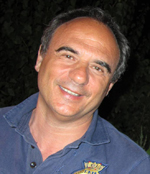
Stefano Nava, MD
With 1,758 beds, the Bologna University Hospital Authority St. Orsola-Malpighi Polyclinic in Bologna, Italy, is one of the country’s largest hospitals. Stefano Nava, MD, leads the respiratory and critical care unit, which houses 30 respiratory beds, seven intensive care beds, a sleep facility, interventional bronchoscopy, and outpatient clinics. Every year, about 10 North American patients visit Dr. Nava’s unit.
“The first thing they ask us is ‘How much are you going to charge me?'” says Dr. Nava, who turns 56 this month. “But we don’t ask for money, which always surprises them.”
Another misconception arises over the treatment. “We have the same equipment, the same protocols as in any U.S. hospital,” Dr. Nava says. “But there’s a sort of myth in the United States that socialized medicine means less quality of care. As a matter of fact, the care of the patients is rather similar. In a certain point of view, it’s the other way around.”
Dr. Nava co-authored the paper “Critical Care Rationing: Internationals Comparisons,” which was published in Chest in 2011. During our conversation, he pointed out that socialized medicine is associated with less emergency admission for certain pathologies. He cited the higher rate of emergency department visits of asthmatic patients in the United States.
“In socialized medicine, everybody is taking drugs that prevent an exacerbation of asthma,” Dr. Nava says. “While in the United States, if you’re poor or you don’t want to pay for insurance, you might underestimate your symptoms. Therefore, you may go more frequently to the emergency room.”
Dr. Nava has served both the ATS in its Critical Care Assembly as well as the European Respiratory Society in several capacities. He also sits on a joint task force between the ATS and ERS on noninvasive ventilation with Drs. Paolo Navalesi, Laurent Brochard, and ATS Immediate Past President Nicholas S. Hill.
The task force aims to keep literature on the subject up to date. The most recent joint document, between the ATS, ERS, European Society Of Intensive Care Medicine, and Société De Réanimation De Langue Française, the “International Consensus Conferences in Intensive Care Medicine: Noninvasive Positive Pressure Ventilation in Acute Respiratory Failure,” was approved by the ATS Board of Directors in 2000.
Dr. Nava remembers a time when the technique wasn’t as common as it is today. “In the 1980s, less than 100 papers were published on the topic in all of the international journals,” Dr. Nava says. “Today, you have more than 5,000 on Medline. The technique really exploded in the past 15 to 20 years.”
In no small part, the explosion is due to the efforts of Dr. Nava, who’s written more than 100 papers on the subject, and a handful of other clinicians and researchers. His paper “Non-Invasive Mechanical Ventilation in the Weaning of Patients with Respiratory Failure Due to Chronic Obstructive Pulmonary Disease: a Randomized Study,” published in the Annals of Internal Medicine in 1998, has been widely cited.
“That was the most quoted because it had very different applications and it was pretty normative at that point in time,” Dr. Nava says. “Since then, several other papers confirmed the results of this study.”
Born in Crema, Italy, Dr. Nava earned his degree in medicine at Pavia University, where he subsequently specialized in pulmonary disease, intensive care medicine, and anesthesiology. Between 1985 and 1988, he took a research fellowship in pulmonary medicine at Royal Victoria Hospital and the Meakins-Christie Laboratories, at McGill University in Canada. It was there, under the tutelage of the venerable professors Joseph Milic-Emili, Francois Bellemare, and the late Peter T. Macklem, that Dr. Nava studied respiratory mechanics and physiology—mainly in invasively ventilated patients.
Around the same time, he attended his first ATS International Conference in New Orleans (he hasn’t missed a conference since).
He returned to Italy inspired and joined other doctors to develop and apply noninvasive techniques in real life modes. “The technique was totally abandoned for decades until it was discovered by an Italian working in Memphis, Tenn.—Umberto Meduri—who applied this technique in a patient who did not want to be intubated,” Dr. Nava says. “It was a patient with a do not intubate order. From that particular study, we started to apply in our patients. Everything came afterwards. It was a sort of huge wave that was increasing year by year.”
After his training at McGill, met Nicolino Ambrosino, MD, and Claudio Fracchia, MD, who co-authored the popular 1998 study among others and performed clinical trials.
“The most relevant results were some physiological studies with negative and positive pressure ventilation and one fundamental innovation like the use of NIV to shorten extubation time in acute respiratory failure from COPD, which has been the basis for further world research,” says Dr. Ambrosino, director of the respiratory unit in the Cardio-Thoracic Department at the University Hospital of Pisa. “But the most relevant quality I appreciate is that Stefano Nava is not the kind of researcher living outside of the real world. He is a brilliant speaker, and his talks seldom are confined to the technical topic but include attention to the contemporary events.”
To Dr. Nava, the most pressing of these contemporary events is the freedom of information. “I find it really disgusting that one should pay for science,” he says. “Everyone involved in medical care should have similar access to scientific knowledge. And blocking the potential knowledge of a physician in Zimbabwe just because he doesn’t have the money to get the paper—I think it’s totally wrong and totally against the Hippocratic Oath. The ATS tries to get the discount to people. But still, medical knowledge is a social need, and everything social should be available for free.”

